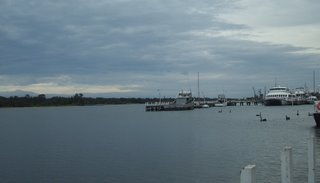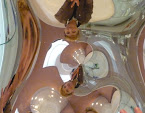skip to main |
skip to sidebar
 The Studio at Sydney Opera House
The Studio at Sydney Opera House
and De Quincey Co present
IMPRO-LAB: transparencies
IMPRO-LAB involves a collaboration with two legendary
Japanese artists, musician Sachiko M (Peril,
Player Piano) and vocalist Ami Yoshida with
renowned Australian artists: dancers Peter Fraser,
Yumi Umiumare, Tony Yap and Tess de Quincey
alongside musicians Jim Denley (Machine for
Making Sense) on wind instruments, Chris
Abrahams (The Necks) on keyboards, poet/vocalist
Amanda Stewart (Machine for Making Sense),
video artist Sam James and lighting designer
Clytie Smith.
Friday 24th & Saturday 25th November
at 8.15pm
The Studio
Sydney Opera House
(Entry fee :Adult $30
*Concession $25)
For more info and booking click here
On the thousand kilometre drive down the east coast's Princes Highway from Sydney to Melbourne, Victoria, as we stopped off in various places I realised that a number of contemporary poets hail from the coast. One such stop was in a dairy farming town on a wide tidal river winding into a picturesque valley of farms sheltered by a distant low range - Moruya, once the childhood home of well-known poet John Tranter, friend, poetry colleague and editor of Jacket. (John's father, a teacher, farmer and soft drink manufacturer, moved the family to Moruya when John was four years old.)
 Tourist brochure - Moruya
We stayed overnight in Bega, another dairy farming town in New South Wales, known for its cheese. A town associated, for me, with another friend, the poet and gardener Denis Gallagher who lived there for some time in the late 1970's/early 1980's. As most places in Bega closed for business around six p.m. and the pubs became disturbing sources of Indigenous peoples' loud existential arguing, we opted for dinner at the Bega RSL (Returned Servicemans' League) Club. It was a world unto itself - thick dark curtains covered every window to screen out daylight and summer's late sunsets and to affect, in fact, permanent evening. One huge room with a long bar and a glassed-in Keno booth on one end. The lurid green walls encased a square of rows of poker machines, smoking areas marked simply by a suspended sign that you step under from the non-smoking part of the room to the other, a pool competition with the usual chalk heiroglyphics on a blackboard and a traditional meat raffle in which a large number of locals participated, hoping to win trays of lamb chops, beef roasts and snags. All of this was accompanied by a cacophonous mix of sounds of the pokies, an enormous Sky channel sports screen, a juke box, the raffle caller and half-shouted conversations.
Tourist brochure - Moruya
We stayed overnight in Bega, another dairy farming town in New South Wales, known for its cheese. A town associated, for me, with another friend, the poet and gardener Denis Gallagher who lived there for some time in the late 1970's/early 1980's. As most places in Bega closed for business around six p.m. and the pubs became disturbing sources of Indigenous peoples' loud existential arguing, we opted for dinner at the Bega RSL (Returned Servicemans' League) Club. It was a world unto itself - thick dark curtains covered every window to screen out daylight and summer's late sunsets and to affect, in fact, permanent evening. One huge room with a long bar and a glassed-in Keno booth on one end. The lurid green walls encased a square of rows of poker machines, smoking areas marked simply by a suspended sign that you step under from the non-smoking part of the room to the other, a pool competition with the usual chalk heiroglyphics on a blackboard and a traditional meat raffle in which a large number of locals participated, hoping to win trays of lamb chops, beef roasts and snags. All of this was accompanied by a cacophonous mix of sounds of the pokies, an enormous Sky channel sports screen, a juke box, the raffle caller and half-shouted conversations.

 Bega RSL Club, November 2006
Further along the highway there were half a dozen ways of heading west towards a hinterland dairy farming town with the slightly comical, beautiful name of Bombala. The formative home town of two experimental poets Michael Farrell and Geraldine McKenzie. Something poetic in the cow's milk on the southern New South Wales coast ?
Crossing the border into Victoria you enter dark logging forests and soon arrive in the coastal towns of East Gippsland. Almost twenty years ago Laurie Duggan wrote a complex, poetic meta-text about Gippsland, from the dispossession of the Indigenous people during early settlement, gold digging, farming, through the years of world wars, rural industry, the Snowy River and its attendant myths and history, and so on, progressing up until the 1980's. The Ash Range compiles journals, newspaper stories, gold prospectors' and others' letters, historical photos, topographical lithographs and Duggan's notes and poems to construct a prose and poetry epic. The last poem in the book canvasses, in its final stanzas, some of the cultural ironies or clashes of 'civilization' and 'the bush' - I remember the final image of a phone booth in the middle of the bush. That book's packed away with the rest of our books and household stuff in storage in Melbourne.
Bega RSL Club, November 2006
Further along the highway there were half a dozen ways of heading west towards a hinterland dairy farming town with the slightly comical, beautiful name of Bombala. The formative home town of two experimental poets Michael Farrell and Geraldine McKenzie. Something poetic in the cow's milk on the southern New South Wales coast ?
Crossing the border into Victoria you enter dark logging forests and soon arrive in the coastal towns of East Gippsland. Almost twenty years ago Laurie Duggan wrote a complex, poetic meta-text about Gippsland, from the dispossession of the Indigenous people during early settlement, gold digging, farming, through the years of world wars, rural industry, the Snowy River and its attendant myths and history, and so on, progressing up until the 1980's. The Ash Range compiles journals, newspaper stories, gold prospectors' and others' letters, historical photos, topographical lithographs and Duggan's notes and poems to construct a prose and poetry epic. The last poem in the book canvasses, in its final stanzas, some of the cultural ironies or clashes of 'civilization' and 'the bush' - I remember the final image of a phone booth in the middle of the bush. That book's packed away with the rest of our books and household stuff in storage in Melbourne.
 Lakes Entrance, East Gippsland, November 2006
Lakes Entrance, East Gippsland, November 2006





